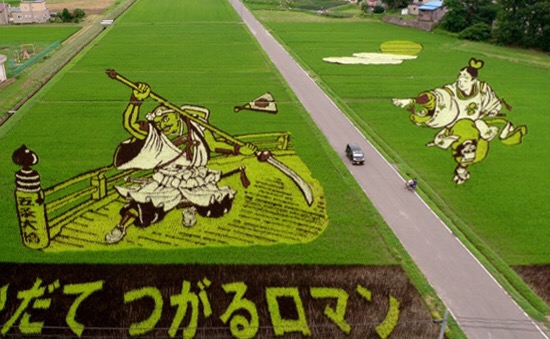Rice Paddy as a Giant Art Canvas in Japan (田んぼアート)
What is Rice Paddy Art?
Rice paddy art (田んぼアート ) is an art form originating in Japan where people plant rice of various types and colors to create a giant pictures in a paddy field.
In 1993, the people of Inakadate, Aomori were looking for a way to revitalize their village. Archaeological exploration led to a realization that rice had been grown in the area for more than 2000 years.To honor this history, the villagers started a rice field behind the town hall.
With the paddy as a canvas, the villagers cultivated and used four different types of heirloom and modern strains of rice to create a giant picture in the field. To allow viewing of the whole picture, a mock castle tower 22 meters high was erected at the village office. In 2006, more than 200,000 people visited the village to see the art.
For the first nine years, the farmers created a simple picture of Mount Iwaki . before going to more complex designs.
Following Inakadate’s example, other villages such as Yonezawa in Yamagata prefecture, have started to create their own tanbo art.
Rice paddy art is an technique unique to Japan which entails selecting a good paddy for a canvas and planting seeds of different colors to create a picture.
This form of art began in Inakadate village, Aomori Prefecture, in 1993 as a means of regional economic revitalization.
Rice paddy art is created in two districts of the village. The first district has a paddy measuring 143m (469 ft.) by 103m (337 ft.), offering a massive canvas spanning 1.5ha (3.7 ac).
Past subjects have come from a wide variety of genres – reproductions of great artworks, characters from Japanese folklore, and images from famous movies and anime. Each year has a set theme. 2017’s motif is Japanese fairytales and legends.
Rice plant seedlings of various colors used for rice paddy art
Rice plant seedlings of various colors used for rice paddy art
The rice plants used to create these amazing pictures are a combination of standard plants used for edible rice, and ornamental varieties grown since ancient times.
The palette includes ten strains of rice plant producing seven colors: green, yellowish-green, yellow, deep violet, white, orange, and red.
After deciding on an image, a rough sketch is made which is then elongated to compensate for viewing the finished work from an elevated, low-angle perspective.
Based on the final design, different varieties of rice plant are selected accordingly. Stakes are driven into the paddy and sectioned off with rope for each colored area of the image.
By early summer, the plants mature and the picture materializes!
You can see rice paddy art from around June to October, but the best season to view the colors at their most vivid is July to August.
-How to go ?
(From major cities by train)
From JR Tokyo station take the Tohoku shinkansen (bullet train) to JR Shin-Aomori station. Transfer to the JR Ou line to Hirosaki station. Total journey time approximately 3 hours and 50 minutes.
JR East Hirosaki Station
(Via Aomori airport)
From Aomori airport take the shuttle bus to JR Hirosaki station (approximately 1 hour).
-After Viewing Rice Paddy Art, Sample the Local Cuisine
Along your journey, make sure to stop in at some of the delicious restaurants around Hirosaki station.
And once you reach Inakadate you must sample some of the Tsugaru region’s local cuisine.
You’ll love the “scallop shell miso hot pot” which uses a real scallop shell to cook a delicious mix of dashi, miso, scallop, egg and onion.
Another signature dish is “keno broth”. Japanese radish, carrot, burdock root, mountain vegetables, deep-fried bean curd and freeze-dried tofu are simmered in miso-flavored broth. It goes great with Japan’s delicious white rice.
Over 350,000 people a year visit Inakadate to see its famed rice paddy art. Created through the power of nature and local residents’ spirit, these grand-scale works of art are even more impressive in person.

